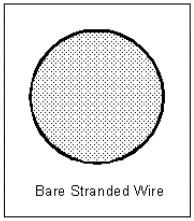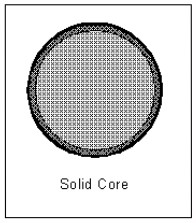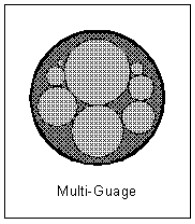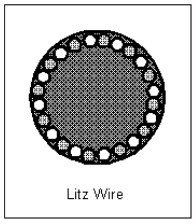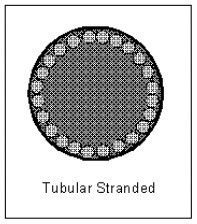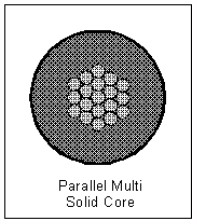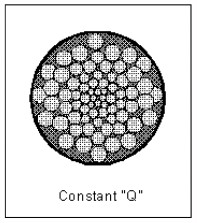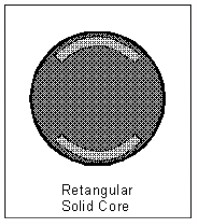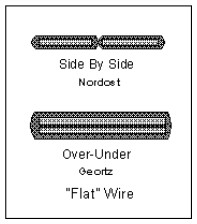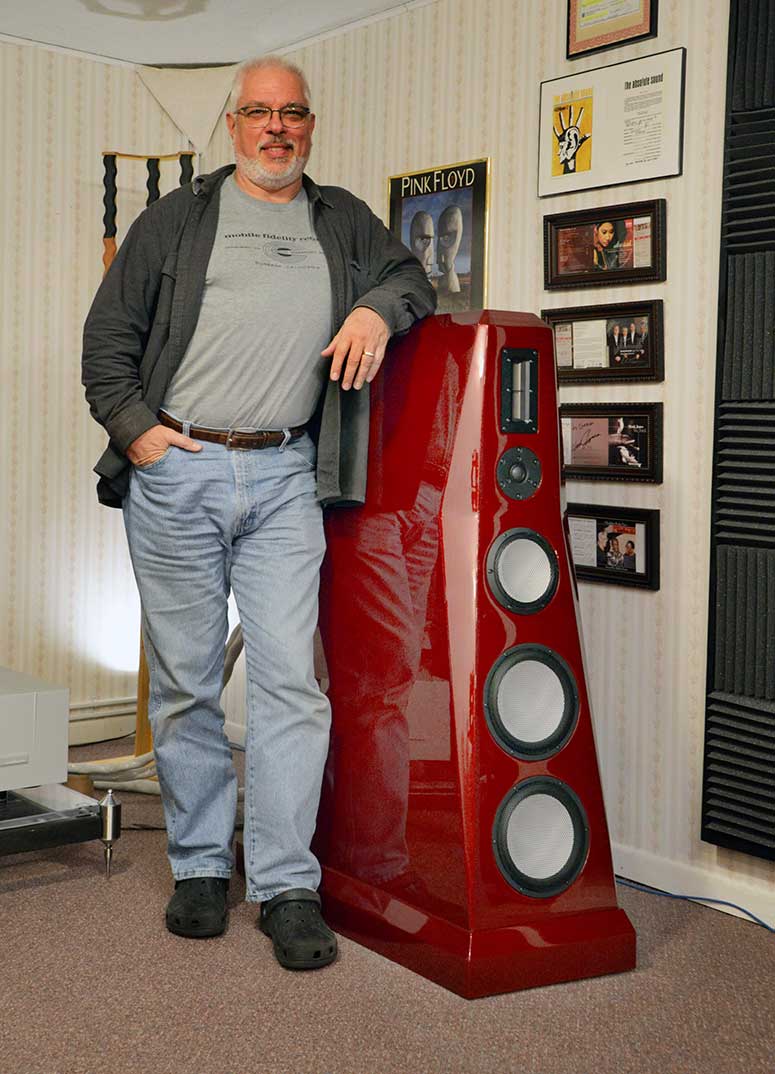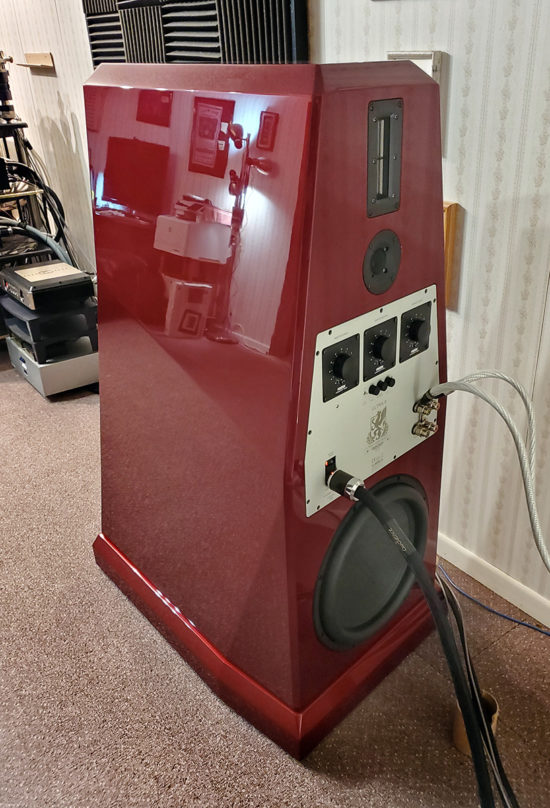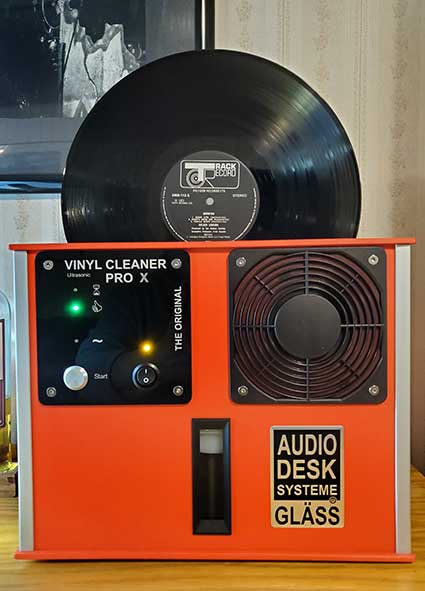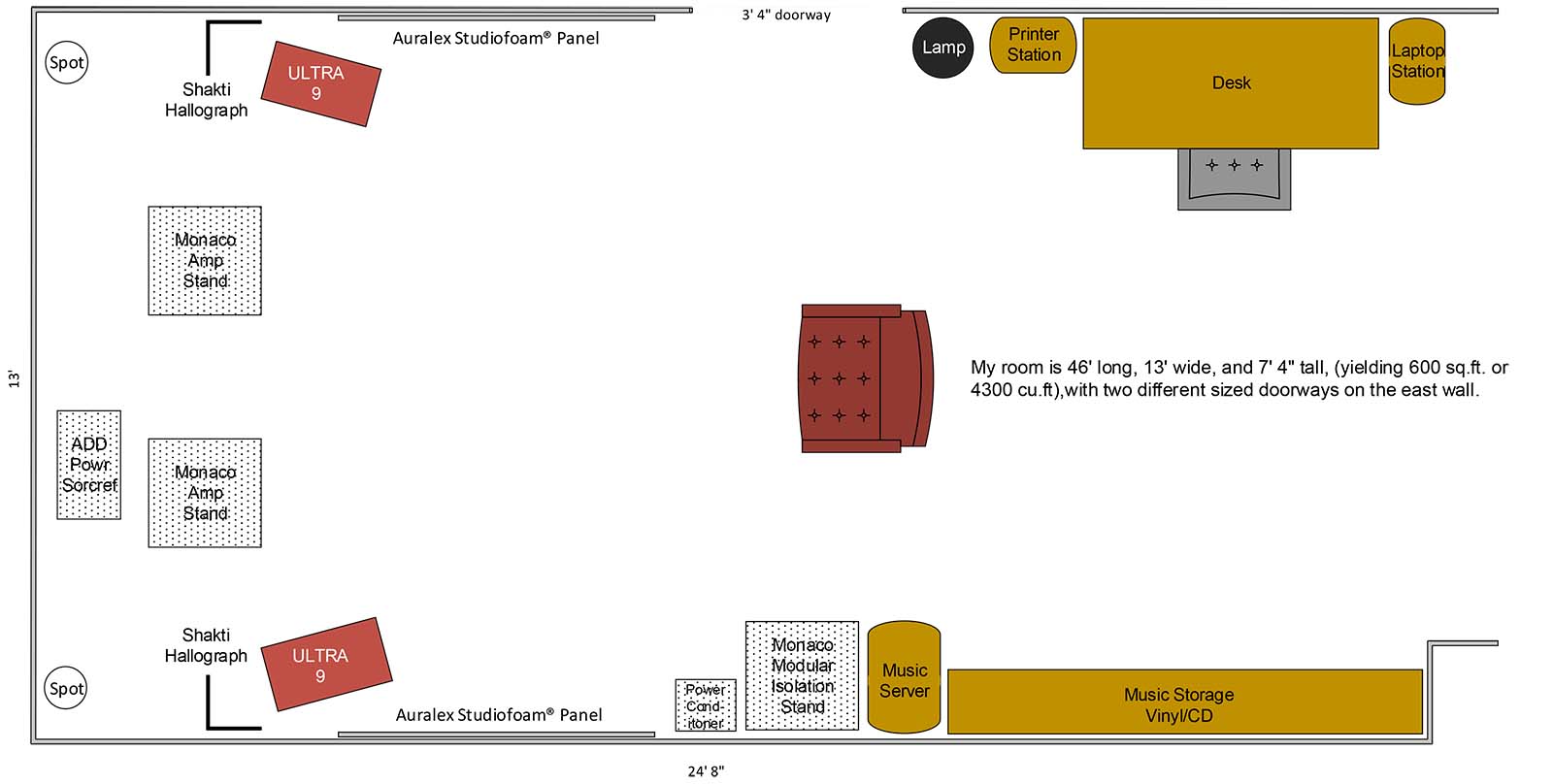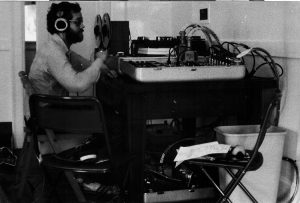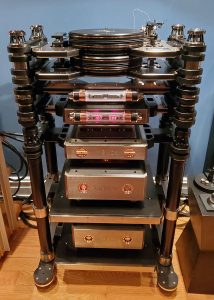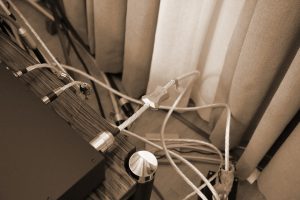As part of Positive Feedback's "New Old Stock" [NOS] series of reprints, Greg Weaver's article from 1997 is presented as a significant article worthy of renewed presentation here. This article was originally written in 1988 and appeared in Volume 1, Issue 2, of the audio analyst©, Winter 1989. It was updated and re-published in Volume 6, No. 6 (Winter 1997, pp. 40-46) of Positive Feedback Magazine (print), and published again at SoundStage!.com. Many thanks to Greg for supplying his article and graphics for PF.
Dr. David W. Robinson, Editor-in-Chief
Probably the most widely known (audio) fad is the use of special speaker cables, which are highly touted for their wonderous effects on the sound. Some of these cables are very well made, and I use them because they are very convenient for snaking across the floor without tangling. But affect the sound? Hardly.
Julian Hirsch, Stereo Review. December 1992
Loudspeaker Cable Satori
Well my friends, if you believe the above statement by Julian "Tin-Ear" Hirsch, either quit reading right now and throw this periodical into the trash can over in the corner, or be prepared to be enlightened.
For years I had read this kind of drivel and had been able to accept it with relative ease. All this talk of expensive exotic speaker cable was, after all, probably just some left-wing fanatical plot to separate me from my money. There was a lot of that going on in those days! And didn't it say in all the popular magazines that wire was wire? I'm not about to part with $40 cash American for something that everyone knows won't make any difference. Shoot dang! That was a lot of music in the late seventies! I could buy roughly 2.6 Mobile Fidelity Sound Labs™ albums, or about 6.6 standard releases, or about 13.33 used albums at Jerry's Records in Pittsburgh, or some other "Pre-Owned Vinyl" emporium.
So why were people I knew spending extra money on bigger, thicker, and, dare I say it, sexier wire? Was it so all the girls they took back to their apartment would swoon at the thickness? Doubtful, but probably worth the try.
But the time came when I simply had to know. Semi-reluctantly, I bought my first sturdily packaged and beautifully terminated pair of the original Monster Cable™ speaker wire, the first "mass market" name to accost the plebeian hoards.
Cursing the blister packaging for its reluctance in giving up its precious contents, I told myself yet again I had simply wasted the money and that I would be sorry about this expenditure. Shaking my head as I hooked up the shining sturdy gold pins, first at the back of my Sherwood receiver and then at each EPI speaker terminal, I told myself reassuringly that at least they did look nice, and the gold pins probably would be quite durable. The cable itself, though much thicker than any I was used to, was quite pliable and easily routed around any obstacles on their way to the speakers. And the clear jacket made it easy to see the high-purity copper inside. So maybe, though these expensive snakes would sound no better than the 18 AWG "zip" cord I had been using, the money was not totally wasted.
I almost hesitated to fire up the system. It was as if the longer I postponed affirming my doubts about the wires the less stinging the insult would be. But I had to know.
I can't tell you for sure what the first piece I played on the wires was (I think it was The Alan Parsons Project Pyramid) but I had to admit, maybe the purchase wasn't such a bad one. The first thing that I noticed was that the high frequencies seemed higher! This was interesting. After listening to about ten albums to convince myself the experimental results were repeatable, I had to admit that although I had changed a supposedly inactive component the sound was more to my liking.
I had no idea then how to explain it or even an interest as to why it might be so. I didn't think about types of wire or wire constructions, I didn't think about inductance, resistance, and capacitance and I didn't really give it a second thought. All I now knew was that different wires indeed sounded different.
Looking back on it now with my acquired electronics savvy, it becomes easy enough to accept. It is almost blatantly obvious that only if we impart absolutely no change to the signal as it travels from source to speaker, could it not have some resultant sonic effect. Unfortunately, every separate component in our music reproduction system (capacitors, diodes, resistors, transistors, even the solder joints which connect these basic components) reacts with the audio signal in some manner. This inevitable reaction thereby adds to, subtracts from, or combines with the audio signal, creating some form of distortion.
All you EE types, please keep in mind that I may tend to focus on a specific attribute of the property under consideration, rather than its entire set. This is not an electronics primer, it is a heuristic treatment. So please don't burst a vessel over the essential simplification! On the other hand, do take me to task if you feel I've misrepresented the trait or have oversimplified. Your feed back and dialogue is always welcomed.
When you are done reading this, hopefully, you will have a little better understanding of how and why wires work and the overall effect they so significantly impart to your system's sound quality. You'll see why they have to be considered "components" and how to better select and optimize the cables you use with your system.
Not All Conductors Are Created Equal
To most of you, twin lead multi-stranded wire is the standard speaker cable. You are probably using the variety and gauge of this type of wire sold to you by the store where you purchase most of your gear. This wire consists of numerous very fine conductors bundled together side by side in a vinyl or plastic sleeve.
No big deal. This is a good, tried-and-true, very flexible, easy-to-terminate wire for most installations. But what about the copper inside the insulation? Most of these wires are made from a grade of copper that is known as "TPC", or Tough-Pitch Copper. Normally, TPC has about 1500 crystals, or grains, in each running foot. This is the quality commonly found in "lamp cord" and really should be avoided whenever possible.
Some of the better wire manufacturers, and in fact almost all the ones who build "audio" quality wire, use what has come to be known as "OFHC", or Oxygen-Free High conductivity copper. This copper is drawn in a way that minimizes its oxygen content: approximately 40 parts per million as compared to the 235 parts per million associated with normal copper. It also reduces the grain per foot count down to about 400. This grade of the metal represents a serious step up from "TPC" and is in part responsible for the higher cost (often a buck a foot or more) of the wire you see sold in audio stores.
This OFHC copper is still not perfect, but the higher purity is very desirable. If we look at the physical makeup of a copper wire, we see it consists of many separate grains of copper stuck together in a long line. Impurities within the copper, including oxygen, silver, iron, sulfur, antimony, aluminum, and arsenic, coalesce at the grain surface, or boundary. This creates a much higher impedance to the electron flow by essentially forcing electrons to have to "jump" those poorly conducting boundaries where grains touch. It's easy to see how reducing the oxygen content and the number of grains per foot can make a wire a much better, more efficient conductor.
Let's take a look at the three previously mentioned major electrical properties of our conductor, inductance (the opposition to AC presented by a circuit), resistance (the opposition to DC presented by a circuit), and capacitance (an electrical characteristic that includes infinite resistance to DC, diminishing impedance with increasing AC frequency and a phase lead for passing signals).
Resistance causes equal losses at all frequencies while inductance causes varying degrees of loss in proportion to frequency. The higher the frequency, the higher the resultant loss. Although most engineers do not acknowledge that the capacitance presented by typical lengths of loudspeaker cable can affect the audio range, recent study has shown that such capacitance has a very real sonic factor, especially on a wires resonance. Resonance, for our discussion, means the buildup of vibration, due to energy storage, and the continued vibration due to the specific periodic release of the energy stored in a circuit after the applied energy is removed.
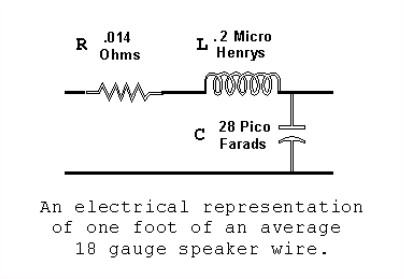
The figure above is an electrical "model" of a basic 18 AWG loudspeaker wire. It shows that per foot, you have on average about .014 ohms (Ω) of resistance, about .2 micro-Henrys (µH) of inductance, and about 28 pico Farads (pF) of capacitance. These values vary widely with differing types of conductors and change during the application of the music signal. So, a twenty-five-foot length of standard speaker cable will have about one-third of an ohm resistance, about five micro-Henrys of inductance, and about 700 pico Farads (or .7 nano Farads) of capacitance. My how 'dey do add up with distance. Obviously, shorter is better, more on that later.
Any of you who have ever attempted crossover design (or have seen an electrical representation of one) can easily recognize the similarity between our "per foot wire model" and the textbook 12dB per octave low pass filter. (Gee, doesn't filter mean to intentionally separate or remove something from the whole? Does that mean that some of the audio is filtered or removed just by passing it through our wire?) After all, a 12dB per octave low pass filter consists of a coil in series with a driver and a capacitor in parallel with it. This arrangement allows lower frequencies to pass on to the driver while inhibiting the progress of the higher frequencies.
Inductance, Capacitance, and Resistance, oh my!
Because wire is itself an electronic component, in that it is a path for the audio signal, its basic attributes may be measured in terms of inductance, resistance, and capacitance. Most research has been confined to cable's inductance and resistance since the levels of capacitance are not "academically" large enough to affect the sound. But, it is so much more complex than the considerably simpler L, C, and R relationships.
Noel Lee, the founder of Monster Cable, feels most distortions heard and attributed to cables can be categorized into three groups. The first deals with frequency integrity, and how accurately the high and low frequencies are transmitted through the conductor. The second deals with time domain integrity, how the conductor affects the resultant arrival times of differing frequencies as they pass through the conductor. Highs are known to travel much faster through most conductors than lows. The third is the dynamic capability of the conductor, how rapidly and consistently it responds to dynamic changes across the audio spectrum. Let's examine how these affect our application.
One of today’s most talked about and more audible electrical characteristics of a cable's performance is known as the "skin effect." The dynamic factors of speaker wire, namely inductance and resistance, work in opposition to each other. Decrease one and the other invariable rises. Most of the difficulties of cable design are hidden until the "skin effect" is taken into account. It works like a variable added inductance, raising resistance with frequency.
It occurs because locally circulating "eddie" currents in individual conductors cause the apparent inner core resistance to increase with frequency. This generates the behavior that causes the skin of the conductor to appear to have the least resistance to current flow. This then incites the electrons flowing in the electrical current through the conductor to impede to the outer surface (or skin) of that conductor. Because the tendency for this to occur also rises with frequency, the higher the frequency, the more pronounced the effect becomes.
According to Bill Low, president of AudioQuest, "The subjective effect in a single strand that is too large, anything above 18-gauge or so, is that the highest octave seems rolled off. The imaging, sense of space, and more subtle information seems to be lost" (Audio Video Interiors, January 1992).
This effect becomes compounded in a multi-strand wire. The entire bundle acts like a single solid core conductor, with much worse effects. Any given individual strand can be found at a different location or depth in relation to the rest of the bundle depending on where we look for that strand within the bundle. It might be at the top when we look at it only one inch into the cable. Yet three feet further down the length of the cable, it might be found at the center or even the bottom of the bundle. Maintaining symmetry of the striations throughout the length of the bundle is so unrealistic as to be considered impossible.
This presents a problem in that, the higher the frequency, the more the current is going to be jumping from strand to strand in its desire to stay on the outermost conductor of the common bundle. Since there is also contact resistance between strands, not all of the current will be able to uniformly stay along the surface of the wire. Every time a strand leaves the surface and goes down into the bundle, some of the current will jump to a new strand in its effort to stay on the surface, thereby following the path of least resistance in accordance with natural law. Unfortunately, the point of contact between strands is actually a simple circuit exhibiting its own capacitance, inductance, and diode rectification, presenting a whole host of problems. This happens thousands of times in cables and is responsible for most of the hashy and gritty sounds common to them. This distortion mechanism is quite dynamic, extremely complex, and tends to worsen over time.
Additionally, most of you who have ever played with electromagnetism in a school classroom will be able to appreciate this next difficulty. Running an electric current through a wire produces a magnetic field around that wire. As that magnetic field expands and contracts with the music signal, it will induce a current in any other conductor that lies within its field of influence. If a wire adjacent to it is carrying a field of its own, the magnetic fields around the two will cause them to attract or repel, just like two bar magnets. This electromagnetic effect serves to further increase the distortion caused by the skin effect. As the magnetic field around each strand changes, the current moves back and forth. This tends to alternately push or pull adjacent wires apart, further increasing the contact resistance.
Here is where something seemingly unimportant is said to come into play, the insulation jacket. Some manufacturers have attempted to attack this last problem in the form of applying a harder jacket. This harder jacket supposedly limits the mechanical movement possible by individual wires, limiting interaction within each bundle somewhat. Although this method is claimed by some manufacturers to yield higher dynamics and less distortion, taken by itself, it has little to no effect on the sonic quality of the wire in my experience.
As if all this weren't enough, this magnetic interaction applies to the second separately insulated bundle of striations just a millimeter or two away in the typical side-by-side twin lead cable. If that second wire is carrying a current of its own, as in the case of a musical signal from the amplifier, the resultant magnetic fields will exhibit a detrimental effect upon each other. The more powerful magnetic fields associated with the bass notes cause the greatest magnetic interaction, which in turn modulates the higher frequencies. The sonic results of this effect manifest themselves in the form of improper phase and time information, causing a broadband smearing of the music.
A common method used to combat this effect is to twist the two conductors around each other into what is called a twisted pair. Twisting the positive and the return conductor together will cancel out some of the intrinsic magnetic field, and as a bonus, reject outside interference as well. This is a very notable method of producing a higher-quality speaker wire and is in common use today. The trick comes in determining the pitch of the twist. It can be very different for differing gauges and configurations.
The capacitive nature of cable introduces group delay, a complex form of time-domain distortion. Group delay (a timing difference between one band of audio frequencies and the rest of the audio spectrum) could, for example, cause the music's harmonics to be reproduced at a slightly different time than the fundamentals.
One more concern is the potential for impedance mismatch between the two ends of our loudspeaker cable. Our loudspeaker wires connect the differing (and under an applied audio signal, widely varying) speaker impedances to the output of your amplifier. Mismatched impedances cause reflections, and those reflections increase the resonance, or ringing, problem. The end-to-end ringing builds into standing waves creating intermodulation products that impose themselves as brightness, graininess, and other similar sonic artifacts that have become accepted as "normal".
Didn't someone say that wire can't possibly make a difference? That is beginning to seem to be a pretty bold and unwarranted statement, no?
Wire Constructions
(Remember that all of my comments below date from 1997. Things have changed a lot since then.
But the basic schema listed below give you the main categories.)
Let's take a quick look at some basic constructions in the world of speaker wire and list briefly the advantages and disadvantages of some of them. I’ll be using some crude images to show cross-sectional views of designs in common use by many manufacturers today.
Stranded wire is the most common type of wire found in use today. Its advantages are that it is quite pliable and affordable. In the minus column are its high relative inductance, ease of corrosion, high "skin effect" and its low "Q", or "ring" point. This wire typically is very resonant and gritty sounding. The best-known example is probably Monster Cable™ original speaker wire.
Solid core wire offers substantial value, given the performance per dollar ratio, with today's "average" system. It is simple, has low DC resistance per unit area, and offers a good resistance-to-capacitance ratio. On the negative side of the equation, it is stiff and therefore hard to handle, has a high relative inductance at higher frequencies, offers a high DC to AC resistance ratio, and has a low "ring" point. Overall sound is much better damped and the soundstage is much improved, but it still is kind of gritty and harsh sounding. The most common examples are Mogami Neglex and the original Tara Space and Time™.
Apologies for the typo in the diagram above!
The multi-gauge configuration yields slightly lower inductivity and a much lower electro-mechanical resonance due to the elimination of strand multiplicity. It still has relatively high inductivity and a high likelihood of corrosion in non-litz applications and is quite pricey. Kimber Kable is the strongest proponent of this geometry, and for good reason. The stuff sounds pretty good. Kimber's methodology is to braid the differing diameter wires together, yielding at once significant induction management and a very unique-looking cable. The 4TC version is available at $5 a foot (and the step-up 8TC at $9 a foot), the price of admission is certainly not outrageous.
The "Litz" wire is one of the most widely used wire constructions. This wire is derived from many finer gauge conductors independently coated with an insulator and is usually constructed in such a fashion as to have two distinct signal paths in one bundle so that both the plus and minus run are under the same insulator. Its qualities include low inductivity, good conductor resistance and inductance to cable capacitance ratios, and it doesn't corrode. Although it sounds quite good, it offers a resonant (or woolly) sound in traditional configurations due to strand multiplicity and interaction and has a severe capacitive effect in longer lengths. More on this particular construction later as it is one of the most widely accepted "good sounding" wires on the market. The Cello Strings III and AudioQuest's Hyper-Litz are good examples of this construction.
The tubular wire offers low inductivity and can be reasonably flexible in stranded versions. Its drawback is a high resistance for a given size and in the solid wall configuration, the wire is unwieldy and prone to be easily damaged. Tubes work by virtue of their thinness. So as an audio conductor, they are limited by the fact that their resistance (and related cable capacitance) goes up as the conductor inductance goes down giving poor resistance to capacitance ratios. Their transient response is typically quite good offering striking control of resonance which ultimately yields very good time domain behavior.
Most tubular stranded constructions incorporate the "Litz" configuration. They can sound mighty fine with the right associated equipment. Tubular stranding (especially when used in the "Litz" configuration) can offset some of the negative attributes of tubular conductors with much success. A common example would be AudioQuest's Hyperlitz cable.
Parallel multi-solid core wire, although offering lower inductivity than some of the other wires, can be limited by high dielectric involvement. While the multiple parallel paths reduce inductive energy storage which fuels resonance, as the audio signal represents a variable electrical field, it must travel in the dielectric medium surrounding the conductor. The primary effect of the dielectric's interaction is to reduce the speed of transmission of the signal, which introduces small yet significant time-domain behavioral problems. They are also quite bulky and exhibit great difficulty maintaining the symmetry throughout the cable, especially as the strand numbers increase. Although the simplest of these constructions are used successfully as interconnects, some have found limited following as speaker wire. AudioQuest uses this geometry in a number of its Hyper-Litz constructions such as the Indigo and Midnight. A tubular assembly of several twisted groups of solid core litz conductors is also used by Monster Cable in their M series of speaker cables, but Tara’s Space and Time™ cables may be seen as the best examples of this type.
The constant "Q" wire, or Golden Ratio wire, uses a unique approach (the "Golden Ratio" was first hit upon by the ancient Greeks, and is specifically a ratio of 1.618:1). The conductor is made up of very fine strands (starting around 41 AWG), built up in layers, each successive layer a Golden Ratio larger and reversed in direction than the last. Every strand is discreet, offering hundreds of paths homogenizing their fields at the conductor level. This construction offers very low inductivity and resistance for the given size, allows excellent capacitance and resistance to inductance ratios, and eliminates electro-mechanical resonance even more so than the multi-gauge geometry. However, due to their complexity, they are labor and time-intensive to build and therefore awfully expensive. They sound particularly good, and if you can afford them, definitely try them if your retailer will loan you a set for appraisal before purchase. This is the bread-and-butter approach of George Cardas, of Cardas Audio.
The Rectangular Solid Core™ construction is a bit of a conglomeration. Slowly drawn and super-annealed pure OFHC copper is used. The proprietary solid rectangular cross-section reduces high-frequency loss and allows for a remarkably high degree of phase linearity. The RSC™ design offers more than twice the skin-to-cross-section ratio of round conductors having equal mass. Two RSC™ strands are then helically wound around an aerospace polymer center to make one approximately 14-gauge conductor in an attempt to provide sufficient capability for dynamic power, low-frequency transmission, and spatial definition.
As an aside, years of research by many different designers and manufacturers has pretty much settled on the "optimum" diameter of a conductor. That diameter is about .040", or 20 mils, and has been chosen because it is the largest diameter attainable before high-frequency attenuation at 20kHz begins to occur due to the skin effect.
The inherent advantage of this design is that it provides a fairly uniform frequency to current distribution in the conductor giving it outstanding overall performance. This is a design that has been patented by Tara Labs, the latest iteration of the RSC™ going for about $800 for an eight-foot pair. The sonic performance of this construction can be summed up in one word - sweet!
Flat cables, or ribbons, offer a fairly low overall inductance, a near match of characteristic impedance and speaker impedance, and high rejection of EMI. They can pass square waves with remarkable ease, indicating their tendency to handle musical transients extremely well. They typically sound remarkably open by their low inductive nature (you've heard the DC to light analogy). But almost all flat conductors I've listened to exhibit an overall lightness in the deepest bass, and start exhibiting a diminishing level around 40 to 45Hz, a result I would attribute to the high capacitive nature of the design.
Goertz is the biggest devotee of the flat cable today (1997) and they offer them in two sizes, and one in silver. The MI 1 is .4 inches wide and .04 inches thick, and fairly cost-effective at about $4.20 a foot, while the MI 2 is .8 inches wide and .04 thick and is available in an Ag II silver conductor design as well as in "6 Nines" copper. The result of placing two solid core .8-inch wide 14-gauge equivalent conductors a mere three one-thousandths of an inch apart, one atop the other, is to really drive down the inductance, raising the capacitance at the same time. Since the characteristic impedance is the square root of the inductance divided by the capacitance, that allows for a characteristic impedance that is in the single digits. This is not so with most other designs, except for the highly complex "network" designs.
As an aside, AudioQuest's F-14, F-18, and F-88 cables, although referred to as "flat" cables, are actually several bundles of Hyper-Litz conductors placed side by side in the insulating jacket.
Exotica
This by no means covers all designs available today, just those that use a basically passive approach. Many other more esoteric approaches exist and almost all of those are quite expensive.
Take Purist Audio Designs, for example. Jim Aud uses a complex water-based fluid as his cable's primary insulator. This exotic insulator is said to provide extreme protection from environmental vibration in their Proteus Speaker Cable (not to mention the fact that now you can obsess over cables that can spring a leak)! This is done in an effort to address the possibility for a cable to have a microphonic effect. Simply put, this means that the cable may reintroduce an analog of the sound produced by the speaker into the feedback loop with varying degrees of detrimental audible results! And, hey, they only cost $4160 for a ten-foot pair!
One of the more rapidly growing design camps are those of the so-called "Network" approach. In this active approach, some type of electronic network (none of the manufacturers seem willing to give specific details) is placed in line with the cable at its termination.
Network designs attack what has come to be called the Power Factor. Because power is a product of voltage and current, any change in voltage or current changes the power factor. When the cable's signal varies with frequency, the cable conducts more power at certain frequencies than at others, causing a sonic emphasis or deemphasis on some portion/portions of the audio spectrum.
The concept of this approach is to attempt to lower the resonant point of the conductor where inductance changes to capacitance. That has been documented as happening at approximately 1300Hz (Stereophile, May 1995), generally speaking. While resistance is relatively easy to design around, inductance and capacitance on the other hand, because they are reactive values that vary and change with the varying AC Signal, can create engineering nightmares. Because of the inherent storage nature of capacitance and inductance, they resist surrendering all the signals they carry and contribute greatly to the resonant character of the conductor under examination. Capacitance is more reactive at low frequencies, while inductance is more reactive to the highs. By more reactive, I mean that the effort required to transmit the audio signal increases, so capacitance resists the passing of low-frequency components, while inductance resists the high frequencies. The true enemies being confronted by designers are energy storage, resonance, and field radiation.
Further, below 1500Hz, cables offer increased resistance and greater storage of the signal. As this mechanism develops, numerous interactions occur broadband, not just at a select frequency, and cause irretrievable loss through cancellation.
The biggest proponents of this design approach are Musical Interface Technologies and Transparent Audio. MIT offers an eight-foot pair of their MH-850 Multi-Bandwidth CVT Terminator Loudspeaker Cable for a mere $9000, while Transparent Audio offers the much more realistically priced eight-foot pair of their Music Wave Loudspeaker Cable for a mere $4000! In all fairness, MIT does build a more affordable unit, the MIT Terminator 3, which sells for $175 per eight-foot pair. And I can say that I’m more than just a little impressed with this cable's timing properties and natural ambiance.
But in reality, while every review I’ve read of these cables is filled with lots of absolutes, for nearly the price of an automobile, they damn well should represent some version of perfection, no? This simply illustrates one of my long-time axioms, that a 2 to 5% increase in performance requires at least a squaring of the current price range. In this case, many of these cables can cost more than most listeners will spend on their entire system.
So, What Can I Do About It
Generally speaking, you should try to use a cable of about 14-gauge equivalent or larger. Budget-minded imaging and bass fans should use twisted pair solid core geometries. Shorter is better, to a point. Too short causes ringing through impedance mismatching. Unequal lengths are verboten, as is excessive coiling. Try any wire someone is willing to loan you! What have you got to lose? Don't be afraid to experiment!
Now that you’ve had time to absorb all of this, the next time someone tells you that wire is wire and has no effect on the sound, stand up and tell 'em it just isn't so! Don't let anybody tell you that loudspeaker cable is not a dynamic component! And tell 'em you know 'cause you read it here. That should start an interesting conversation!
Copyright the audio analyst©, all rights reserved; re-publication without the prior and express written consent of the audio analyst© is strictly prohibited.




